Epstein N., Grace J.R. Spouted and Spout-Fluid Beds: Fundamentals and Applications
Подождите немного. Документ загружается.


Catalytic reactors and their modeling 307
and
U
a
dC
Aa
dz
+
1
A
a
·
d
(
U
a
A
a
)
dz
(
C
Aa
−C
As
)
+ k
(
1 − ε
a
)
C
Aa
= 0. (19.2)
The modeling predicted the reactor overall conversion with varying k, D, U, d
p
, and H.
Excluding the last parameter, which surprisingly generated a maximum conversion for
a bed depth lower than H
m
(caused by simplifying assumptions and a combination of
hydrodynamic features), all other results were in line with expectations. The predicted
conversion was compared with those for fixed and fluidized beds. The drawback of
spouted beds was shown to be gas bypassing through the spout. The use of a spouted
bed as a catalytic reactor appeared to be confined to relatively fast reactions, where the
reaction rate is unaffected by the particle size. It was strongly recommended that studies
be conducted to confirm the theoretical conclusions.
2
Some modifications to the first theoretical account were introduced
5
to describe the
performance of spouted beds (SBs) and spout-fluid beds (SFBs). After assuming that
D
s
is identical for the two configurations, the spout voidage was assumed to be linearly
proportional to z. The velocity field in the SB annulus was modified to compensate for
overestimation. As a result, the reactor conversion no longer showed its maximum value
at H < H
m
for fast reactions. The overall conversion generated by the SFB is usually
greater than for the SB because of greater flow of gas in the annulus.
Experimental results were later presented, together with modeling improvements.
6
Diffusional mass transfer between spout and annulus was added to the earlier two-
region model. In addition, a novel representation of the annulus was proposed, the
so-called streamtube model (see Figure 19.2): it is represented by a variable number of
concentric annular pathlines of increasing length, radiating outward, each collecting gas
crossflowing from the spout into the annulus; the integral of the ascending gas flowrate is
consistent with the Mamuro and Hattori
4
velocity profile. The experiments were carried
out in a 0.155-m ID vessel, adding ozone to the spouting air and decomposing it on an
alumina-supported iron oxide catalyst, crushed to particle fractions in the 0.82 to 2.00
mm range. The agreement between the calculated and measured annulus and overall
concentrations was good.
This project was continued
7
by scaling up the unit t o 0.22 m ID and by refining
the scrutiny scale of measurement at the top of the annulus. Sampling from the spout
was accomplished by online ozone measurement. Because of the characteristics of the
catalyst granules, it was possible to operate with spherical particles decreasing from
4.4 to 2.6 mm in diameter by progressive milling during the tests, while maintaining
their original internal porosity and catalytic activity. The reaction rate constant k was
varied from 1.5 to 63 s
−1
by varying the temperature from 290 to 335 K. Within the
ranges of the operating parameters explored, detailed investigation of the larger column
shed light on the concentration profiles along the annulus radial coordinate. Figure 19.3
compares the predictions of both the one-dimensional and streamtube models with
the experimental results; the experimental profile, which is intermediate between the
predictions of the two models, suggests that the one-dimensional two-region description
is oversimplified, whereas the streamtube representation requires some radial dispersion
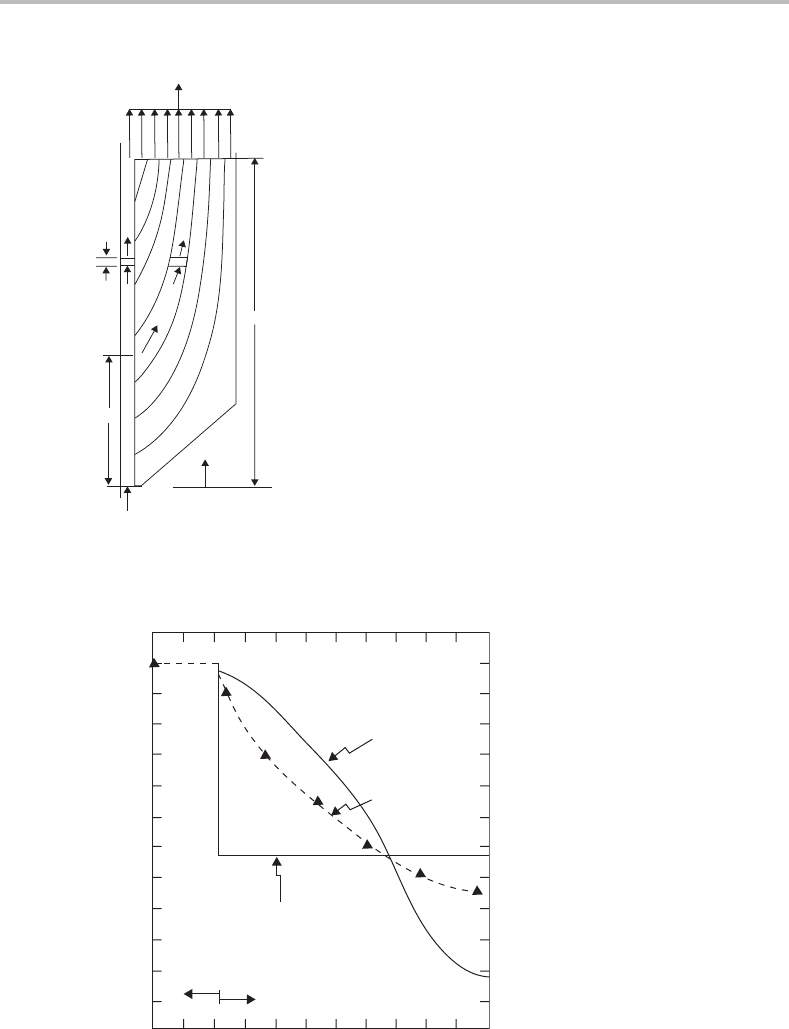
308 Giorgio Rovero and Norberto Piccinini
Q
tot
C
exit
Q
tot
C
in
Q
at
Q
SH
C
SH
C
q
+ dC
o
C
g
+ dC
g
C
a
C
g
C
aiH
dz
Zi
z
H
Spout
Annulus
Qo
t
i = 2
i
=
1
ε
Figure 19.2. Section through spouted bed showing streamlines, concentrations, and flows used in
streamtube model.
6
100
96
92
88
84
80
76
020406080
annulus
spout
one-dimensional model
(C
H
/C
0
) × 100
experimental
profile
streamtube model
prediction
100
r (mm)
Figure 19.3. Dimensionless exit concentration profiles for 0.22 m column,
7
k = 1.53 s
−1
.Overall
C
H
/C
0
: experimental outlet value = 0.95, experimental integrated average = 0.90, predicted =
0.89.

Catalytic reactors and their modeling 309
between the streamtubes to make its prediction less steep radially. An alternative could
be offered by a modified Mamuro and Hattori axial velocity profile in the annulus to
account for gas recirculation at the bottom of spouted beds; such a modification could
be described by a well-mixed region ahead of the streamlines, changing their respective
lengths and receiving gas of more uniform concentration.
The mass balances for the reactant, written in dimensionless form, together with
all the equations needed to evaluate the required quantities, led to a new complete
theoretical model
8
for a first-order isothermal catalytic SB reactor. This model can apply
to coarse spherical particles. Its outputs were compared to predictions from the earlier
one-dimensional and streamtube models. Owing to a more favorable spout–annulus gas
distribution, the new model predicts slightly higher conversion. However, the average
deviation (11%, instead of 5% for the other models) was approximately double with
respect to the experimental data in the 0.15-m unit.
5
The first nonisothermal model
9
considered an adiabatic spouted bed catalytic unit for
the dehydrogenation of ethylbenzene, an endothermic first-order irreversible reaction.
Separate energy balances were required for the spout and annulus, interacting across
their interface by bulk flows of gas and particles. For these conditions, axial and radial
diffusional resistances within the phases were of negligible importance. Within the
individual phases, no mass and heat transfer resistances were considered between the
catalyst particles and gas. The model was developed by an a priori approach including
all equations that provide the annulus–spout gas distribution, U
mf
, U
ms
, H
m
, D
s
, ε
s
and a
simplified description of the particle circulation velocities. Dynamic material balances
were written for the spout and the annulus, respectively, as:
∂C
As
∂t
=−u
s
∂C
As
∂z
− k
0
(
1 − ε
s
)
ex p(−E/R
g
T
s
)C
As
(19.3)
and
∂C
Aa
∂t
=−u
a
∂C
Aa
∂z
+
∂u
a
∂z
(C
As
− C
Aa
) − k
0
(1 − ε
a
)ex p(−E/R
g
T
a
)C
Aa
. (19.4)
Analogously the energy balances for the spout and annulus were written in the form:
C
ps
∂T
s
∂t
=−
(ρC
p
)
g
u
gs
+ (ρC
p
)
p
v
ps
∂T
s
∂z
+ (ρC
p
)
p
∂v
ps
∂z
(T
a
− T
s
)
+(−H)k
0
(1 − ε
s
)ex p
−E/R
g
T
s
C
As
(19.5)
and
C
pa
∂T
a
∂t
=
(ρC
p
)
p
v
pa
− (ρC
p
)
g
u
ga
∂T
a
∂z
+ (ρC
p
)
p
∂u
ga
∂z
(T
s
− T
a
)
+
(
−H
)
k
0
(
1 − ε
a
)
ex p(−E/R
g
T
a
)C
Aa
. (19.6)
As a first step, steady state was studied, erasing the transient terms and resulting in ordi-
nary differential equations. Two cases, a flat-bottomed and a conical-bottomed vessel,
were described, giving the same functional form to the annulus velocity and a cone-
function of z to the cross-sectional area. The fractional exit conversion was evaluated as

310 Giorgio Rovero and Norberto Piccinini
a function of D, H, θ , d
p
, and U/U
ms
. The sensitivity analysis of the last variable demon-
strated that, by moderately increasing the gas velocity, additional solids circulation was
obtained with more convective heat transfer to the annulus and an improved reaction
rate, sufficient to compensate for increased gas bypassing in the spout.
A dynamic analysis
10
with 10 percent changes in temperature and inlet concentration
demonstrated different responses for the spout and annulus, because of their different
thermal capacity and particle/fluid interaction. New steady states were obtained after a
20- to 30-min transition. A moderate flow rate increase at the inlet initially caused an
inverse response, followed by overall similar dynamics. The operability goals defined
the control system design: the output concentration was selected as the control variable,
with the inlet concentration as the main disturbance and the temperature or inlet flow
rate as manipulated variables. Several control schemes were simulated and compared.
In a concise communication,
11
it was demonstrated that the “one-dimensional model”
and “streamtube model” do not provide different overall conversions when a first-order
reaction is considered, provided that the same hydrodynamic representations and the
same mass transfer assumptions are included in both models. Based on general reactor
engineering considerations, it was proved that the one-dimensional model predicts higher
overall conversions for reactions of order less than unity, whereas the streamtube model
generates higher conversions for reaction orders greater than one. It was noted that if the
problem were tackled by a detailed experimental program, radial concentration profiles
at different depths in the annulus would be helpful in discriminating between the models.
A fur ther simple model was based on a phenomenological evaluation of the gas
hydrodynamics, with the spout having well-defined plug flow, whereas some mixing
was inferred in the annulus. This description
12
was defined as “semicompartmental,” as
the annulus was represented by two perfectly mixed regions in series. By assuming an
annulus gas velocity profile as given by the Mamuro and Hattori equation,
4
evaluated at
the dimensionless bed heights, z/H, of 0.25 and 0.75, the description of the two stages was
straightforward. The predicted overall gas conversion was a function of d
p
, k, U/U
ms
, and
a spout–annulus mass transfer coefficient. No maximum conversion was predicted with
increasing bed depth, unlike the original model.
2
The experimental results available at
that time were in s atisfactory ag r eement, although the semicompartmental representation
makes no allowance for radial variations in the reacting species concentration.
19.2 Applied studies
An exothermic reaction, CO oxidation over a Co
3
O
4
/α-Al
2
O
3
catalyst, was used to
demonstrate the validity of a reactor model
13
for an adiabatic spouted bed. The theoretical
description was based a priori on the definition of all variables acting in a spouted bed
reactor. Considering a flat-based vessel, the model refers to an inlet region in which the
gas expands before generating the actual spout, the peripheral annulus, a fountain core
as an extension of the spout, and an axisymmetric downflowing fountain. The model
predicted that the fountain contributed significantly to the reaction. Heat generated on
the catalyst particles was then transferred to the gas by convection, as in a slowly moving
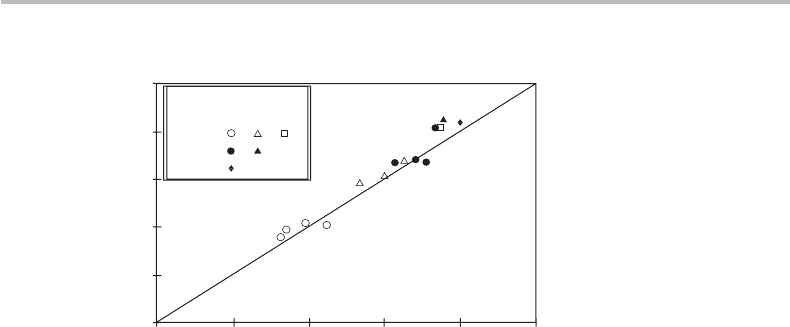
Catalytic reactors and their modeling 311
1.0
0.8
0.6
T
i
(K)
473
498
523
Feed wt. %CO
0.6 1.0 1.3
0.4
0.2
0.0
0.0 0.2 0.4 0.6 0.8 1.0
Experimental Conversion
Predicted Conversion
Figure 19.4. Comparison of experimental data with model predictions of overall reactor
conversion.
13
Operating conditions: D = 0.1 m, H = 0.17 m, D
i
= 16 mm. Reprinted with
permission of John Wiley & Sons, Inc.
packed bed. These two conditions apply specifically to fast reactions and combustion.
Separate energy balances were written for the solids and gaseous phases. All regions
required voidage profiles and circulation rates, including a detailed description of the
fountain, which had previously been neglected in spouted bed reactor models. The motion
of particles in the annulus strictly followed streamlines, to satisfy both continuity with
the spout loading and energy balances. The recursive numerical solution of the equation
system required a sequence of steps:
(1) Read the input data.
(2) Calculate the hydrodynamic parameters.
(3) Calculate t he annulus fluid flow field.
(4) Calculate t he mass flow rate profiles and annulus particle velocity field.
(5) Calculate t he annulus particle velocity balance.
(6) Calculate t he spout mass and energy balance.
(7) Calculate t he annulus particle energy balance.
(8) Calculate the annulus fluid mass and energy balance.
(9) Calculate t he fountain mass and energy balances.
(10) Verify step 6.
The convergence criterion was a negligible change in temperature in the annulus, as
this region provides a critical contribution to the overall reactant conversion. Model
predictions were compared with the experimental data in a unit with D = 0.11 m, H =
0.17 m, d
p
= 3 mm, and D
i
= 16 mm, operating at 200
◦
C to 250
◦
C and about 210 kPa
absolute pressure. It is seen in Figure 19.4 that the experimental results agree well with
model predictions.
The catalytic disproportionation of propylene to ethylene and butylene under quasi-
isothermal conditions was also investigated
14
in a small spouted bed (D = 0.05 m, H =
0.12 m, D
i
= 0.002 m), operated with a fine WO
3
-on-SiO
2
catalyst (d
p
= 0.14 mm and
ρ
p
= 740 kg/m
3
). Radial and axial conversions were measured at 673 K and 201 kPa
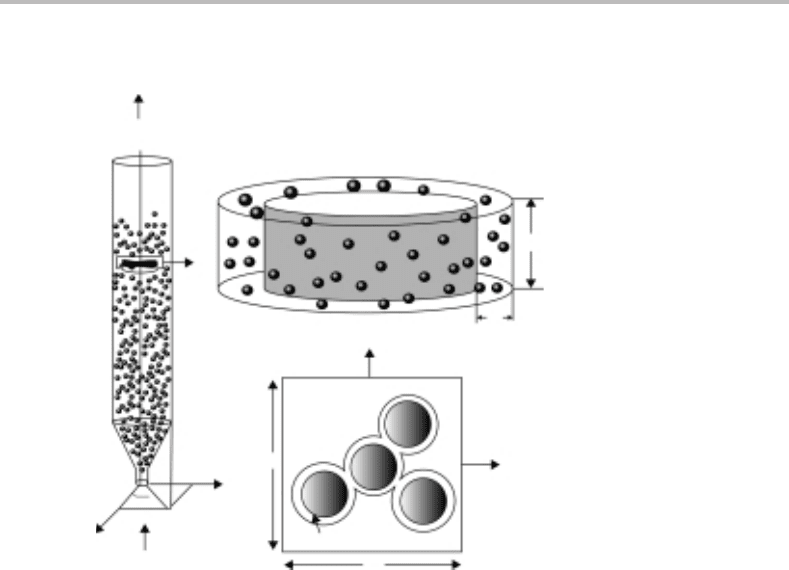
312 Giorgio Rovero and Norberto Piccinini
Product
z
x
y
(x,y,z) or (r,θ,z)
u
z
r
H=
Fluid cell
Mass transfer coefficient k
g
D
AB
C
A
C
B
p
E
Reactant
u
r
Δr
Δz
Δz
Δr
Figure 19.5. Axisymmetric representation of a spouted bed in cylindrical coordinates with
fluid-particle flow field for a two-dimensional model cell.
15
for gas flowrates covering an unusually broad range for spouted beds (1.21 < U/U
ms
<
3.21). The reactant and product concentrations were measured by gas chromatography
on samples from the spout, in the middle of the annulus, and at the wall; positive
radial conversion gradients were confirmed. Because gas velocity in the annulus was
not influenced by the overall gas flowrate, the experimental results suggest that the
contacting efficiency between catalyst and gas could be improved by increasing the
system turbulence. However, the conversion measured at the annulus top was always
much lower than expected from the experimental profiles or calculated from the simple
“one-dimensional,” “streamtube,” or “one-dimensional with axial dispersion” models.
In the last case, the experimental and calculated axial profiles were compared, with the
Peclet number, Pe
D
(z), varied from 0.1 to 1.0. Optimizing reactor models for spouted
bed reactors should include axial and radial velocity profiles, solids mixing, and spout–
annulus mass transfer, to consider mixing in the conical bottom and plug flow with some
axial dispersion in the cylindrical part.
A computational fluid dynamic model based on equations of particle motion, gas
motion, and mass conservation was developed
15
to predict the s patial par ticle distribution
and the unconverted reactant distribution. The motion of particles was evaluated by a
force balance that included the effects of gravitational, contact and drag forces. The
model was based on the discrete element method (DEM) (see Chapter 4). Figure 19.5
shows the spouted bed unit, the axisymmetric geometry, and a model cell. A first-
order irreversible reaction (catalyzed ozone decomposition) was chosen for the mass

Catalytic reactors and their modeling 313
0.5
t = 0.00 s t = 0.08 s t = 0.16 s t = 0.50 s
Bed height (m)
0.4
0.3
0.2
0.1
Dimensionless radial position
–1 –1 –1 –1 –1 –1 –1 –10
0
Dimensionless ozone concentration in solid phase (C
A,S
/C
A0
)
Dimensionless ozone concentration in gas phase (C
A
/C
A0
)
0.0 0.01-0.50 0.51-0.60 0.61-0.70 0.71-0.80 0.81-0.90
0.6 0.7 0.8 0.9 1.0
0.91-1.00
000 000011 1 11111
<
Figure 19.6. Predicted
15
particle distribution (left member of each pair) and unconverted ozone
mole fraction (right member of each pair) distributions in gas and particle phases as functions of
time with U = 2.28 m/s.
conservation equations of the unconverted reactant in the gas phase and within the
porous particles. Three types of equations were solved simultaneously to give profiles of
particle velocity and void fraction, gas flow field, and the conversion of the reactant in the
system. The operating conditions reported in a previous experimental study
7
were fitted
into the model to predict the ozone concentration and particle motion starting from a
static initial condition. The system was predicted to reach steady state in about 0.5 s (see
Figure 19.6). The predictions are compared with experimental results in Figure 19.7,
demonstrating reasonably good agreement with the calculated profile at z/H = 1, but
the earlier streamtube model
6
gives a somewhat better overall representation.
19.3 Conical spouted bed reactors
The features of a conical spouted bed (CcSB) reactor operating in a jet mode were studied
by Olazar et al.
16
The reaction (polymerization of benzyl alcohol) was characterized by
product sticking (because of temperature) and particle size heterogeneity (caused by
growth of a polymer coating on the fine catalyst). An important feature of this kind of
reactor, with respect to conventional spouted and bubbling fluidized beds, is that highly
exothermic reactions can be carried out isothermally, without significant segregation in
the solids phase.
17
Several aspects of CcSBs were investigated: (1) critical geometric
factors, (2) design hydrodynamic correlations, (3) hydrodynamic model of the reactor,
and (4) experimental model validation. An optimal cone angle in the range from 20
◦
to 45
◦
guarantees operability in terms of cyclic solid motion and gas residence time
distribution. The D
i
/D
o
ratio influences the pressure drop and dead zone formation.
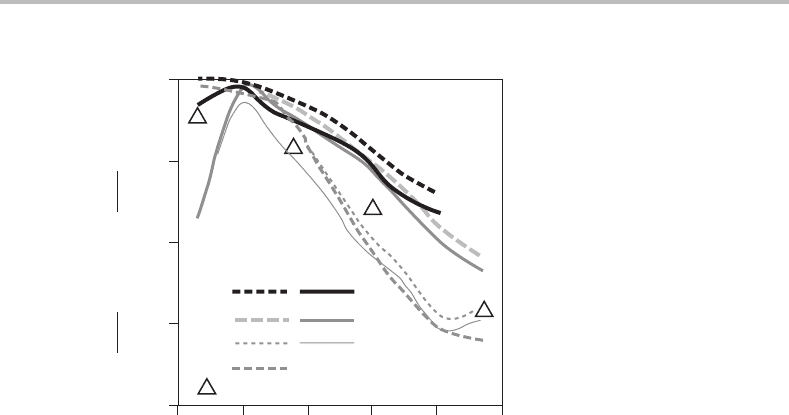
314 Giorgio Rovero and Norberto Piccinini
0.9
0.8
0.7
0.6
0 0.2
0.2
0.3
0.4
1.0
Experimental
C
As
C
A
C
A0
C
A0
0.4 0.6 0.8
Dimensionless Radial Position (r/R)
Gas
Solidz/Z
1
1
Figure 19.7. Radial profiles of unconverted ozone fraction at different heights for t = 4 s in gas
and porous particle phases.
15
Comparison with the experiments
6
for d
p
= 4.4 mm, catalyst
loading: 3.93 kg (40,000 particles); U = 2.44 m/s.
D
i
/d
p
sets an operable reactor voidage. Previously proposed correlations for U
ms
, P
and P
M
were verified. The reactor was divided into a number of conical streamtubes,
each described by a one-dimensional unsteady-state mass conservation equation in plug
flow, with longitudinal dispersion coefficient, D
z
, obtained by fitting all the streamtubes
for the gas phase with helium as tracer, for a range of experimental conditions. The
polymer productivity was obtained by continuously running an automated laboratory
reactor, changing the mean residence time of the catalyst and the par tial pressure of
benzyl alcohol.
In a subsequent paper,
18
the calculation steps for a CcSB simulation were presented
after extending the governing mass conservation equation for an elemental volume
of a streamtube to the reaction term. The polymerization rate derived from the liter-
ature also contained an expression for catalyst deactivation.
19
In principle, this sim-
ulation can apply to systems with catalyst circulation or other reactions. The calcu-
lation routine predicts the distribution activity of the catalyst, particle size distribu-
tion, flow rates of the gas phase and of the reactant, dispersion coefficient, radial and
longitudinal profiles of gas velocity, reactant concentration profile, catalyst flow rate,
and polymer production. Thanks to the simplified hydrodynamics, reactor scaleup is
straightforward.
Continuous in situ pyrolysis of sawdust
20,21
was carried out for a CcSB, in which
a small amount (10 g with d
p
= 0.7 to 1.35 mm) of HZSM-5 zeolite catalyst was
fluidized in a dilute mode. The biomass alone was treated thermally to obtain the yield
and composition of the products. A conical spouted bed seems to offer an optimal
geometric configuration in terms of handling heterogeneous materials, mixing of the
various bed solids components (biomass and catalyst), and a very short gas residence
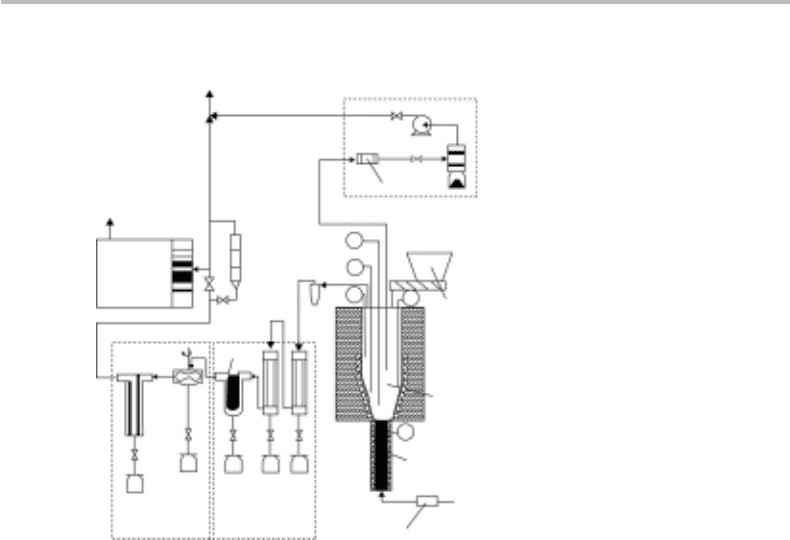
Catalytic reactors and their modeling 315
Gaseous product
Char extraction
Char quenching
Vent
GC
Flowmeter
TC
TC
TC
TC
TC
Cyclon
Sawdust
Hopper
Reactor
Preheater
Mass flowmeter
Condensers
Centrifuge
+
filter
Organic
liquid fraction
Aqueous
liquid fraction
ice
N
z
Figure 19.8. Schematic of continuous pyrolysis experimental unit.
20, 21
Copyright
C
2000
American Institute of Chemical Engineers (AIChE). Used with permission.
time. The geometric structure of t he experimental unit (see Figure 19.8) had a total
height of 0.34 m, D = 0.12 m, H
c
= 0.21 m, D
0
= 0.02 m, D
i
= 0.01 m, and a cone
included angle of 28
◦
. The CcSB was operated at 400
◦
C, 450
◦
C, and 500
◦
C with 10
to 14 L/min of nitrogen for as long as 5 h with pneumatic char extraction from the
top. The bed was spouted at U/U
ms
= 1.2 with a gas residence time of 50 ms in the
bed and 20 ms in the spout. Typical results are shown in Figure 19.9: gaseous products
reached higher yields at higher temperature owing to the catalytic effect. In addition,
the catalyst modified the liquid phase, with the organic fraction converted to aqueous
soluble products because of reduction reactions, leading to a more stable and less
corrosive fuel.
In a related study, catalytic pyrolysis of biomass was carried out batchwise in a
conical spouted bed
22
and compared with ther mal pyrolysis: the kinetic scheme, kinetic
constants, and yields of products in the gaseous, light liquid, and heavy liquid fractions
were obtained. The goal of the process was to maximize the gas yield at the expense
of the liquid products, which had limitations as bio-oils. The unit was the same as
described in the previous work.
21
It operated at 673 K; 2 g of pine sawdust were dropped
into 26 g of a sand/catalyst mixture, varying the active solids mass fraction from 0 to
100 percent. The sawdust was in a size range of 0.8 to 2 mm, and the catalyst was
zeolite/bentonite/alumina in a 25/30/45 percent blend. The gas yields increased with
a larger fraction of catalyst, with the ultimate effect of transforming heavy liquids into
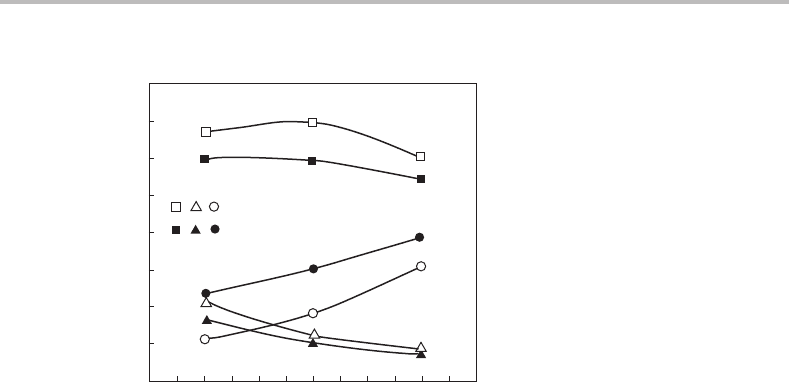
316 Giorgio Rovero and Norberto Piccinini
80
60
without catalyst
with catalyst
gas
liquid
char
40
yield (wt %)
20
0
375 400 425 450 475 500 525
T (°C)
Figure 19.9. Effect of catalyst on distribution of products in pyrolysis of sawdust at different
temperatures.
20, 21
Copyright
C
2000 American Institute of Chemical Engineers (AIChE). Used
with permission.
gases, water, and less oxygenated liquid matter, which may undergo downstream steam
reforming to generate syngas.
To obtain value from plastics residues, pyrolysis is one of the most practiced processes
in fluidization studies, as well as being promising for implementation on a large scale.
The use of acid catalysts offers advantages in shifting the process toward increased
selectivity of products at lower temperatures. In this situation, conical spouted bed reac-
tors are favorable because they operate in a diluted and well-mixed mode, efficiently
preventing sticking and lump formation. An account
23
appeared in which a previously
described
20,21
reactor was applied to HDPE pyrolysis (3 g of chips per batch) in 100 g
of HZSM-5 zeolite catalyst. The operating temperature was set at 450
◦
C and 500
◦
C
with N
2
as the spouting gas at a velocity 20 percent in excess of the minimum spouting
value. Polymer decomposition was completed in 150 s and 120 s, with peak rates at
80 s and 50 s. About 55 percent of light olefins, 15 percent of light alkanes, 29
percent of gasoline fraction, and minimal heavy compounds and char residue were
generated.
The catalytic partial oxidation of methane to syngas was investigated
24
inaCcSB
with D = 0.05 m operated at 900
◦
C to 1000
◦
CusingaNi/La/Al
2
O
3
catalyst (d
p
=
150–200 μm and 600 μm). Experimental limitations, as well as process considerations,
suggested particles significantly finer than those typically employed in spouted beds.
Because of the lack of data, spouting was verified for hydrodynamic conditions simulat-
ing the actual process. The motion in the reactor appeared to be particularly favorable to
preserve the catalytic activity over time, thanks to oxidation and reduction cycles while
spouting with reaction. The hydrodynamics of the CcSB permitted a catalyst formulation
(Ni concentration) more effective than that required by dense systems, leading to high
CH
4
conversions and high selectivity to syngas.
